Gravitationally lensed Neutrino Emission from X-ray Pulsars
Mar 2025
|
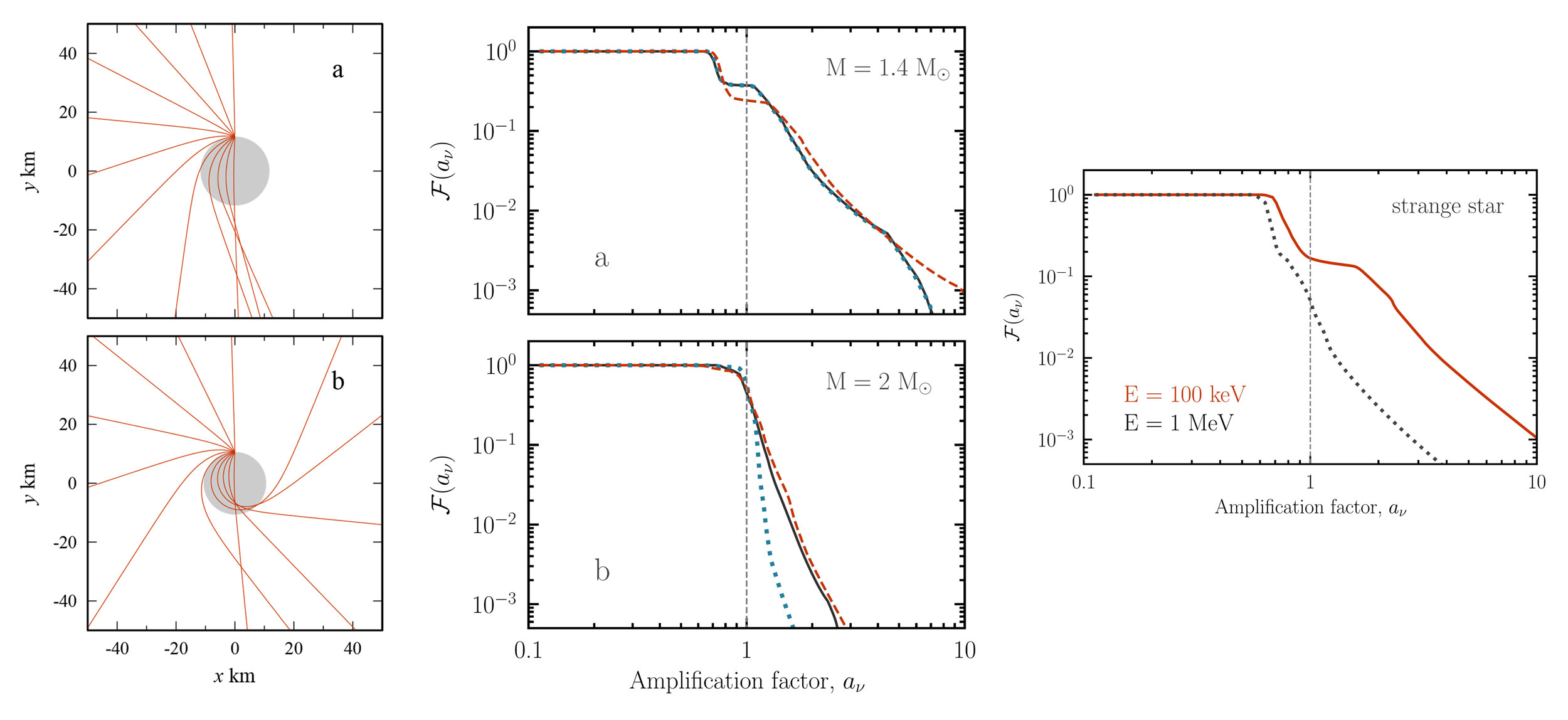
Did you know that neutron stars (NSs) become transparent to neutrinos shortly after a supernova explosion?
A new study published by our team delves into the fascinating phenomena surrounding X-ray pulsars and their potential as neutrino sources.
We explore the role of extreme mass accretion rates in X-ray pulsars, revealing how these systems can generate neutrinos in the MeV energy band.
Our findings highlight a critical process where neutrinos emitted near the surface of NSs undergo gravitational bending,
leading to a distinct beam pattern — a phenomenon we term "neutrino pulsars."
Apparently, the energy flux of neutrinos, when averaged over the pulsar’s rotation period, can differ significantly from the typical isotropic neutrino flux. This has significant implications for the detectability of bright pulsars in neutrino sky.
Through detailed simulations, we estimate the potential discrepancy between the true and apparent neutrino luminosities of NSs.
Interestingly, our research shows that in certain cases, the apparent luminosity could be more than ten times greater than the actual luminosity, though this amplification only occurs in a small fraction of neutron stars. Stronger amplification is less common in more massive stars, and for strange stars, some of the high-energy neutrinos can be absorbed.
[see the article]
|
|
New Insights into X-Ray Pulsar Behavior During Giant Outburst
Dec 2024
|
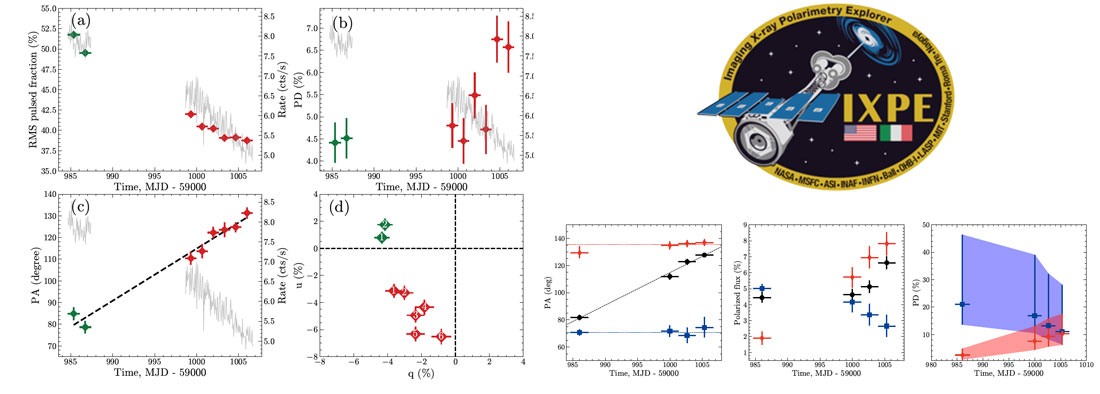
In a new research led by Dr. QingChang Zhao, we has conducted an in-depth polarimetric study of the transient X-ray pulsar RX J0440.9+4431/LS V +44 17, using data from NASA's Imaging X-ray Polarimetry Explorer during its remarkable 2023 giant outburst. This investigation provides valuable insights into the polarization properties of X-ray emissions and the complex mechanisms driving these phenomena. Through time-resolved and phase-resolved analyses, the study uncovered a continuous rotation of the phase-averaged polarization angle (PA) throughout the pulsar's super-critical and sub-critical regimes. To delve deeper into the origins of this PA rotation, the we applied the rotating vector model (RVM) to data from four distinct time intervals, each spanning approximately three days. The study revealed significant changes in the system's geometric parameters over just 20 days, suggesting the presence of an additional polarized component beyond the RVM component. Using an advanced two-component polarimetric model, researchers determined that the gradual shift in the balance between variable and constant polarized flux components was the driving factor behind the observed PA rotation. Unlike previously assumed, this rotation was found to be independent of the accretion regimes, marking a paradigm shift in our understanding of X-ray pulsar behavior during outbursts. These findings open new avenues for studying polarized X-ray emissions and their implications for high-energy astrophysical phenomena.
[see the article]
|
|
The brightest X-ray pulsar observed by IXPE
Oct 2024
The Imaging X-ray Polarimetry Explorer (IXPE) has shed new light on the fascinating behavior of X-ray pulsars (XRPs) by providing detailed polarimetric measurements. Recent IXPE observations of SMC X-1, one of the rare XRPs exhibiting super-orbital variability, offer groundbreaking insights into its high-energy properties.
SMC X-1, observed during the high state of its super-orbital period, is the brightest XRP ever studied by IXPE, with a luminosity of \(L \sim 2 \times 10^{38} \, \text{erg} \, \text{s}^{-1}\) in the 2–8 keV band. Significant polarization was detected across three observations, with phase-averaged polarization degrees (\(PD\)) of \(3.2 \pm 0.8\%\), \(3.0 \pm 0.9\%\), and \(5.5 \pm 1.1\%\), alongside polarization angles (\(PA\)) of \(97^\circ \pm 8^\circ\), \(90^\circ \pm 8^\circ\), and \(80^\circ \pm 6^\circ\), respectively.
The phase-resolved analysis revealed that polarization degrees ranged from \(2\%\) to \(10\%\), with corresponding \(PA\) values spanning \(70^\circ\) to \(100^\circ\). Interestingly, the pulse-phase resolved \(PD\) exhibited an anti-correlation with flux, while the pulsar's position angle evolved over time, potentially due to different super-orbital phases.
Researchers suggest that scattering in the wind of the precessing accretion disk could explain the observed polarimetric behavior during SMC X-1's high state. These findings advance our understanding of XRP geometries and the complex processes governing their emission.
[see the article]
|
|
New Insights into Neutron Star Emissions: The Quest for a Redshifted 2.2 MeV Line
Sep 2024
Our latest research delves into the fascinating realm of accreting neutron stars, exploring the elusive redshifted
2.2 MeV gamma-ray line. This spectral line, produced by neutron capture in extreme gravitational and magnetic
environments, holds the key to understanding neutron star equations of state and nuclear reactions in these exotic conditions.
Through a detailed analysis of data from the SPectrometer on board INTEGRAL (SPI), we investigated a representative
sample of accreting neutron stars. While no redshifted 2.2 MeV line was detected, we derived 3σ upper limits on
the line intensity across different scenarios. These findings provide critical benchmarks for the development of
next-generation gamma-ray telescopes designed to bridge the observational MeV gap.
Our study highlights the need for a dramatic leap in sensitivity for future missions. For instance, detecting the
2.2 MeV line in a bright X-ray binary like Sco X-1 would require a 3σ sensitivity of approximately
\(10^{-6}\,{\rm photons\,cm^{-2}\,s^{-1}}\)—two orders of magnitude better than current capabilities.
As we approach the conclusion of the INTEGRAL mission, this research underscores the exciting potential of advancing
our understanding of accreting neutron stars and the extreme physics they embody. Stay tuned for more updates as we
continue to push the boundaries of astrophysical discovery!
[see the article]
|
|
Cygnus X-3 revealed as a Galactic ultraluminous X-ray source by IXPE
Aug 2024
|
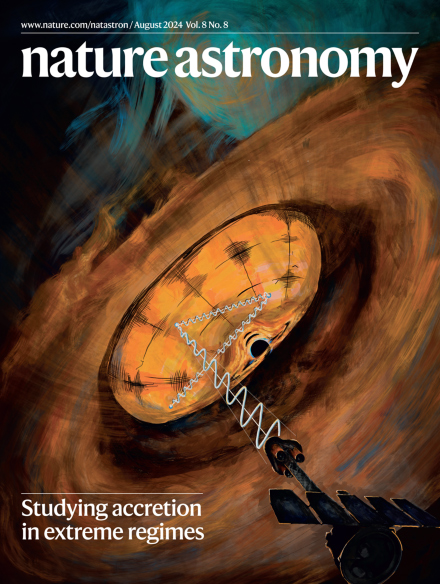
The paper led by Sasha Veledina where I co-authored and my illustration is featured on the cover of Nature Astronomy's August issue!
Our results, based on data from NASA's Imaging X-ray Polarimetry Explorer, show that the famous Galactic X-ray binary Cygnus X-3 undergoes accretion at super-Eddington rates and can be classified as an ultraluminous X-ray source.
[see the article]
|
|
Studying geometry of the ULX pulsar Swift J0243.6+6124 using X-ray and optical polarimetry
May 2024
Pulsations discovered from several ultra-luminous X-ray (ULX) sources have shown that neutron star accretion can produce luminosities far exceeding the Eddington limit. However, the conditions and geometry of such high-luminosity accretion flows remain debated. Pulse phase-resolved polarization measurements from IXPE can help determine pulsar geometry and its orientation relative to the orbital plane, testing various ULX pulsar models. In a new paper led by Prof. Juri Poutanen, we present results from three IXPE observations of the Galactic ULX pulsar Swift J0243.6+6124 during its 2023 outburst. We observe strong variations in polarization with pulsar phase. The average polarization degree increased from about 5% to 15% as the flux decreased threefold. The polarization angle (PA) showed two peaks in the first two observations but shifted to a sawtooth pattern in the last set, inconsistent with a simple rotating vector model. By assuming an additional constant polarized component, we fit the data with a common rotating vector model, obtaining constraints on pulsar geometry: an inclination of 15-40 degrees to the line-of-sight, a magnetic obliquity of 60-80 degrees, and a spin position angle of -50 degrees, differing from the constant component PA of about 10 degrees. Combining these X-ray measurements with optical PA, we suggest a 30-degree misalignment between the pulsar spin and the binary orbital axis.
[see the article]
|

|
The evidence of gravitationally lensed and eclipsed accretion column
Apr 2024
|
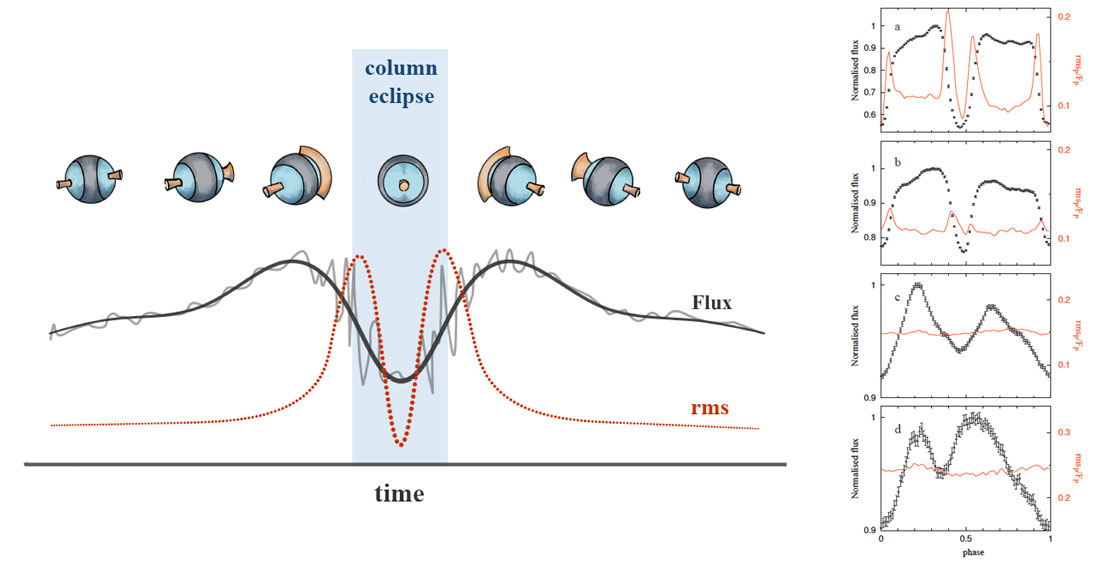
Our new paper delves into the process of pulse profile formation in bright X-ray pulsars, considering stochastic fluctuations in the mass accretion rate, corresponding variations in accretion column geometry, and gravitational bending of X-ray photons. Through our analysis, we unveil potential eclipses of accretion columns by a neutron star during their spin period, which exhibit distinct features in pulse profile variability. Employing a novel pulse profile analysis technique, we successfully identify these features in the bright X-ray transient V 0332+53. This detection provides compelling evidence for the eclipse of an accretion column by a neutron star.
The detection of the eclipse allows us to place constraints on the relationship between neutron star mass, radius, and accretion column height. Specifically, we can establish an upper limit on the accretion column height, crucial for refining theoretical models of extreme accretion. This opens up the possibility of a new independent method to estimate the radius of a neutron star in the future, leading to constraints on the equation of state of extremely dense matter.
[see the article]
|
|
Coupling of radiation and magnetospheric accretion flow in ULX pulsars
Mar 2024
|
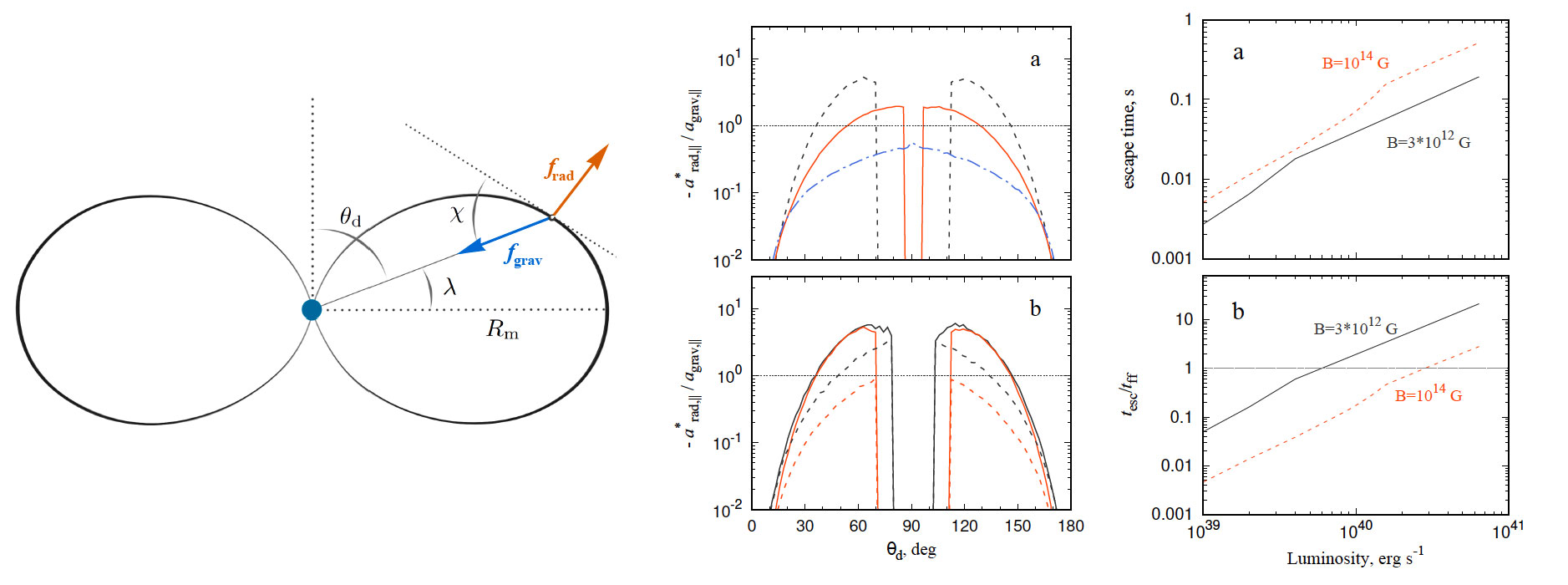
In a new paper written with my student Caitlyn Flexer, we investigate the radiation pressure on the accretion flow inside the magnetosphere of bright X-ray pulsars. Such objects manifest themselves as pulsating ultra-luminous X-ray sources. In such systems, photons born close to the surface of a neutron star experience many reflections from the flow of matter covering the magnetosphere before they escape and begin their journey to the observer. In each act of interaction of radiation and matter, there is a transfer of momentum from radiation to the flow. As a result, calculating the radiation pressure is a non-trivial task. We numerically simulated the process of multiple interactions of radiation with matter and wrote a code that calculates the radiation pressure force across and along magnetic field lines. It is interesting that in some cases the characteristic photon escape time from the system is comparable or even exceeds the free fall time scale in the system. This means that the distribution of radiation pressure across the magnetosphere is not at once, but gradually adapts to the structure of the accretion flow. As a result, the radiation and the accretion flow are couplings already at large distances from a neutron star. The understanding of this circumstance should be especially important for the further construction of numerical models of extreme accretion on neutron stars.
[see the article]
|
|
Accretion flow instability at super-Eddington regime of X-ray pulsars
Feb 2024
|

In a new paper, we delve into the stability of accretion flow in the most luminous magnets in the Universe - bright X-ray pulsars. The accretion flow in these systems should be optically thick and form a cocoon around the neutron star, which prevents us from seeing the star directly. Consequently, the behavior of this flow intricately shapes the observable features of these celestial bodies, including their spectral signatures, flicker patterns, and polarization properties. At low mass accretion rates, the dynamic of the flow's dynamics are predominantly influenced by the gravitational pull and magnetospheric rotation. However, as luminosity approaches or surpasses the Eddington limit, the radiative force emerges as an additional influential factor, further shaping the accretion dynamics. We simulate accretion flow dynamics over the magnetosphere. We show that under conditions of high mass accretion rates, the accretion flow experiences instability, manifesting in quasi-periodic fluctuations with characteristic periods comparable to the free-fall time from the inner disc radius. Notably, the inclination of the magnetic dipole relative to the disc plane and the pronounced anisotropy of X-ray emissions serve to stabilize the mass accretion rate primarily at the poles of the star. However, even under these stabilizing influences, the surface density enveloping the magnetosphere exhibits fluctuating behavior, offering valuable insights into the intricate dynamics at play.
[see the article]
|
|
Cyclotron line evolution in X-ray pulsar A0535+262
Feb 2024
|
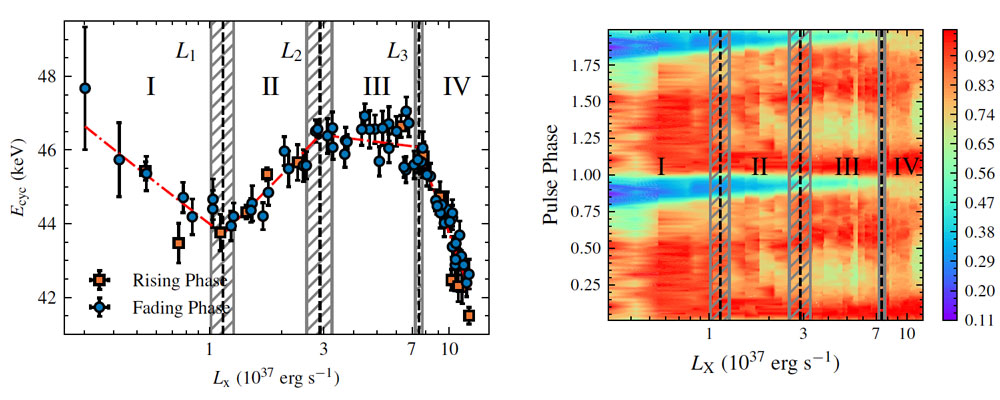
Cyclotron lines in the spectra of strongly magnetized neutron stars have been a subject of study for decades. Particularly in the case of accreting strongly magnetized neutron stars, known as X-ray pulsars, cyclotron lines serve as crucial tools for measuring the magnetic field at the stellar surface and probing the geometry of the emitting regions.
In a recent paper led by Dr. Qing Shui, we present a comprehensive analysis of the cyclotron absorption line energy's dependence on X-ray luminosity in X-ray pulsar 1A 0535+262 during its 2020 giant outburst. Our findings reveal a negative correlation between the line energy and luminosity at high states (luminosity exceeding \(7\times 10^{37}\)erg/s), whereas a positive correlation is observed at lower luminosity levels (ranging from \(10^{37}\) to \(3\times 10^{37}\) erg/s). Similar behavior in cyclotron line energy has been documented in a few other pulsars and extensively discussed in existing literature.
However, a noteworthy anomaly arises at low luminosity levels, \(\lesssim 10^{37}\) erg/s, where we once again observe a negative correlation. Notably, only one other source, the X-ray pulsar GRO J1008-57, exhibits a comparable feature at such low states of accretion (refer to the paper by Chen et al., 2021). The nature of the negative correlation at low mass accretion rates remains unknown and gives room for theoretical reflection.
[see the article]
|
|
X-ray Polarization Reveals the Precessions of the Neutron Star in Hercules X-1
Nov 2023
|
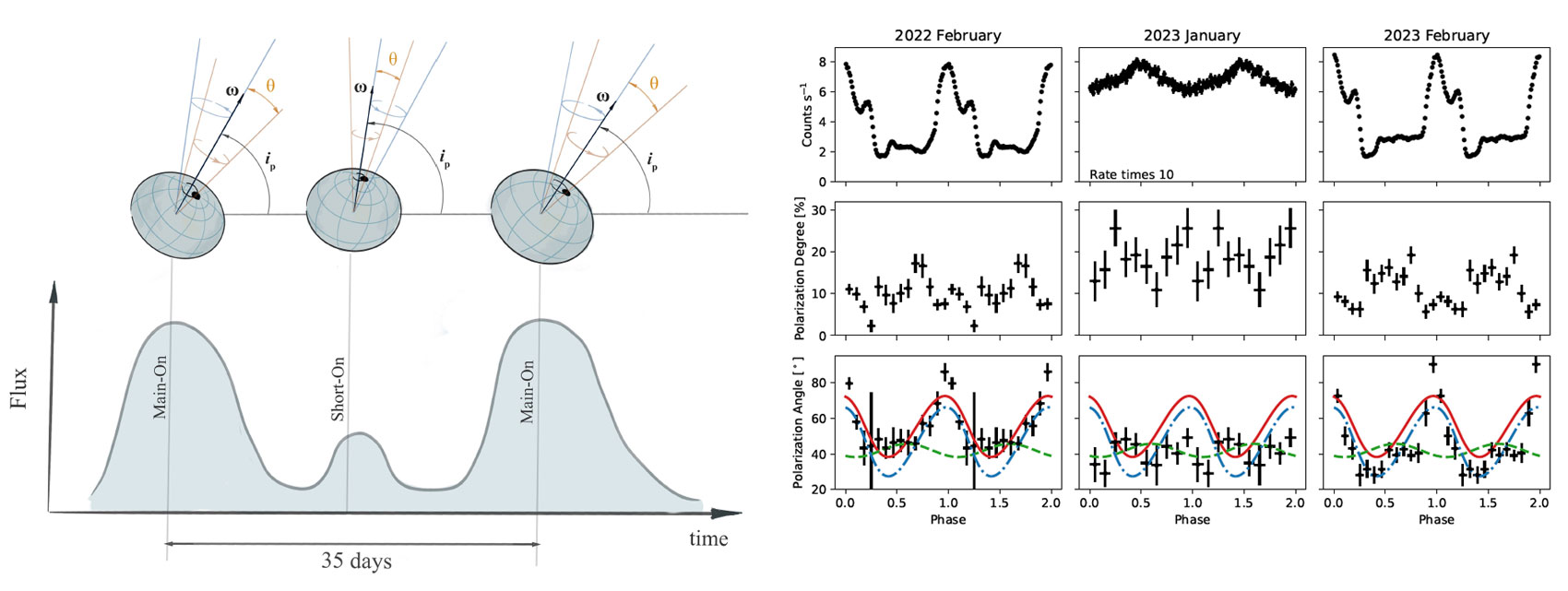
In an accreting X-ray pulsar, a neutron star accretes matter from a stellar companion through an accretion disk. The high magnetic field of the rotating neutron star disrupts the inner edge of the disc, funneling the gas to flow onto the magnetic poles on its surface. Hercules X-1 is in many ways the prototypical X-ray pulsar; it shows persistent X-ray emission and it resides with its companion HZ Her, a two-solar-mass star, at about 7 kpc from Earth. Its emission varies on three distinct timescales: the neutron star rotates every 1.2 sec, it is eclipsed by its companion each 1.7 days, and the system exhibits a superorbital period of 35 days which has remained remarkably stable since its discovery. Several lines of evidence point to the source of this variation as the precession of the accretion disc, the precession of the neutron star or both. Despite the many hints over the past fifty years, the precession of the neutron star itself has yet not been confirmed or refuted. We here present X-ray polarization measurements with the Imaging X-ray Polarimetry Explorer (IXPE) which probe the spin geometry of the neutron star. These observations provide direct evidence that the 35-day-period is set by the free precession of the neutron star crust, which has the important implication that its crust is somewhat asymmetric fractionally by a few parts per ten million. Furthermore, we find indications that the basic spin geometry of the neutron star is altered by torques on timescale of a few hundred days.
[see the article]
|
|
Apparent luminosity and pulsed fraction affected by gravitational lensing of accretion columns in bright X-ray pulsars
Oct 2023
|
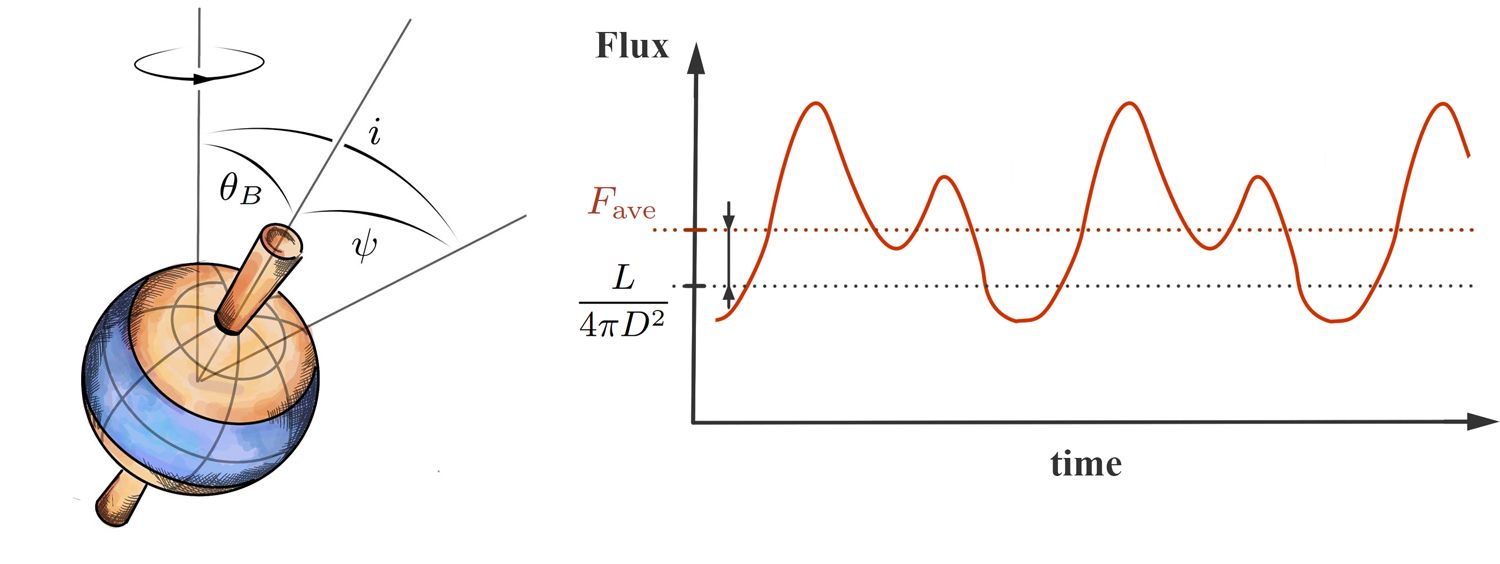
The radiation from X-ray pulsars is not isotropic. Because of this, among other things, we see pulsations from these sources. In bright pulsars we expect to see accretion columns - formations that are supported by internal radiation pressure and confined by extremely strong magnetic field of a neutron star. The radiation from an accretion column is gravitationally lensed by a neutron star, and therefore in bright pulsars we can expect strong non-isotropic emission. Then it is not quite clear how the observed and actual luminosity of a neutron star are related. To find out, we performed numerical modelling of the process of pulsation formation in bright pulsars, where we took into account GR effects and uncertainties in the knowledge of the rotational geometry of the neutron star.
As a result:
(1) In spite of gravitational lensing the discrepancies between actual and apparent luminosity are small, and in 90% of cases your error will be within 20%.
(2) The growth of the accretion column with luminosity at some point leads to a sharp increase pulsed fraction. Such a phenomenon has already been observed in several transients including V0332+53, SMC X-3 and RX J0209.6-7427. The detection of jumps in pulsed fraction could potentially help to separate direct accretion column emission in the signal.
Details can be found in our article with my former Master student Ivan Markozov, now accepted to MNRAS.
[see the article]
|
|
Supercritical X-ray pulsar RX J0440.9+4431
Summer 2023
|
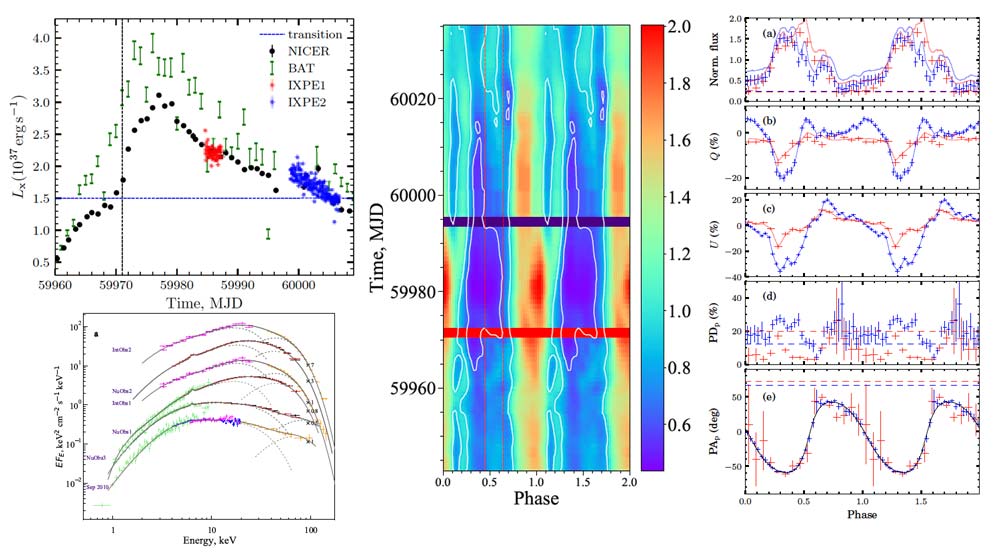
In the beginning of 2023 the Be transient X-ray pulsar RX J0440.9+4431 underwent a fist-ever giant outburst observed from the source peaking in the beginning of February and reaching peak luminosity of \(\sim 4.3\times 10^{37}\) erg/s. In a paper led by Alexander Salganik, we present the results of a detailed spectral and temporal study of the source based on NuSTAR, INTEGRAL, Swift, and NICER observations performed during the outburst and covering wide range of energies and luminosities. We attempted to estimate field using several indirect methods and conclude that all of them point to a relatively strong field of around \(B\sim 10^{13}\)G.
In the paper led by Victor Doroshenko, we report on IXPE observations of RX J0440.9+4431 made at two luminosity levels during the outburst. Considering the observed spectral variability and changes in the pulse profiles, the source was likely caught in supercritical and subcritical states with significantly different emission-region geometry, associated with the presence of accretion columns and hot spots, respectively.
We focus on the pulse-phase-resolved polarimetric analysis and find that the observed dependencies of the polarization degree and polarization angle (PA) on the pulse phase are drastically different for the two observations. The observed differences imply dramatic variations in the spin axis inclination, the position angle, and the magnetic colatitude by tens of degrees within the space of just a few days. We suggest that the apparent changes in the observed PA phase dependence are predominantly related to the presence of an unpulsed polarized component in addition to the polarized radiation associated with the pulsar itself. We suggest that the additional polarized component is likely produced by scattering of the pulsar radiation in the equatorial disk wind.
[see the article on spectral/temporal study]
[see the article on polarisation]
|
|
New IXPE results in the field of X-ray pulsars
May 2023
|
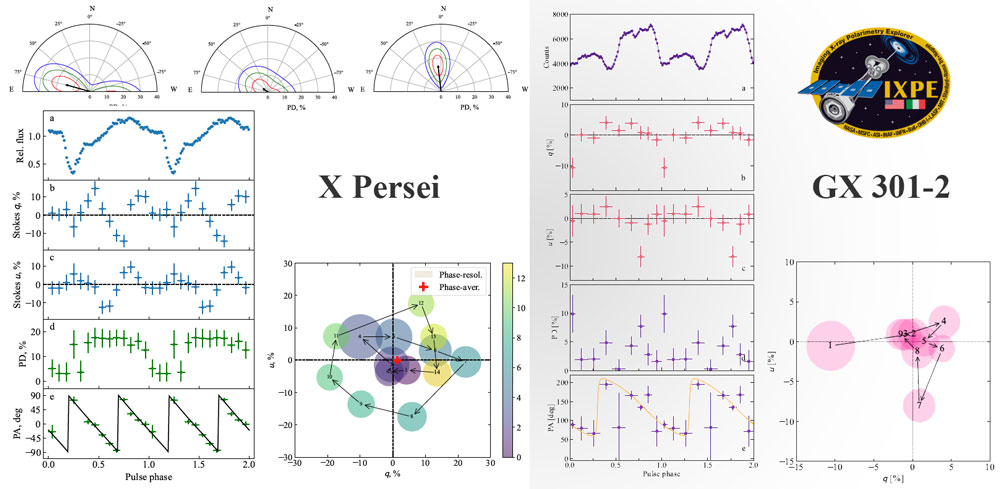
Observations of two more X-ray pulsars by the IXPE observatory have been recently published. This time they are X Persei and GX 301-2. The degree of polarisation in X-rays (like it is for other observed pulsars) is unexpectedly small. In both cases it was been possible to determine the geometry of the neutron star rotation. Interestingly, in the case of X Persei we again see an orthogonal rotator, as in the case of GRO J1008-57.
So, perhaps we should reconsider our ideas about how torques act in systems with accretion onto strongly magnetised neutron stars.
[see the article on X Persei]
[see the article on GX 301-2]
|
|
Bright X-ray pulsars as sources of MeV neutrinos in the sky
Apr 2023
|
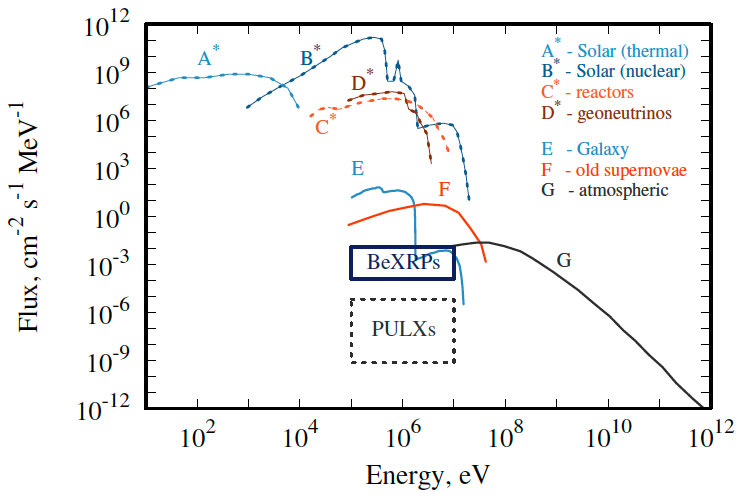
In a new paper led by my student Aman Asthana, we investigate the possibility of detecting bright X-ray pulsars in neutrino sky.
According to our understanding, high mass accretion rate onto strongly magnetised neutron stars results in the appearance of accretion columns supported by the radiation pressure and confined by the strong magnetic field of a star.
At mass accretion rates above \(\sim 10^{19}\) g/s, accretion columns become advective.
Under such conditions, a noticeable part of the total energy release can be carried away by neutrinos and anti-neutrinos of a MeV energy range.
Relying on a simple model of the neutrino luminosity of accreting strongly magnetised neutron stars, we estimate the neutrino energy fluxes expected from six ULX pulsars known up to date and three brightest Be X-ray transits hosting magnetised neutron stars.
Despite the large neutrino luminosity expected in ULX pulsars, the neutrino energy flux from the Be X-ray transients of our Galaxy, SMC and LMC is dominant.
However, the neutrino flux from the brightest X-ray transients is estimated to be below the isotropic background by two orders of magnitude at least, which makes impossible direct registration of neutrino emission from accreting strongly magnetised neutron stars nowadays.
[see the article]
|
|
IXPE observations of the quintessential wind-accreting X-ray pulsar Vela X-1
Mar 2023
|
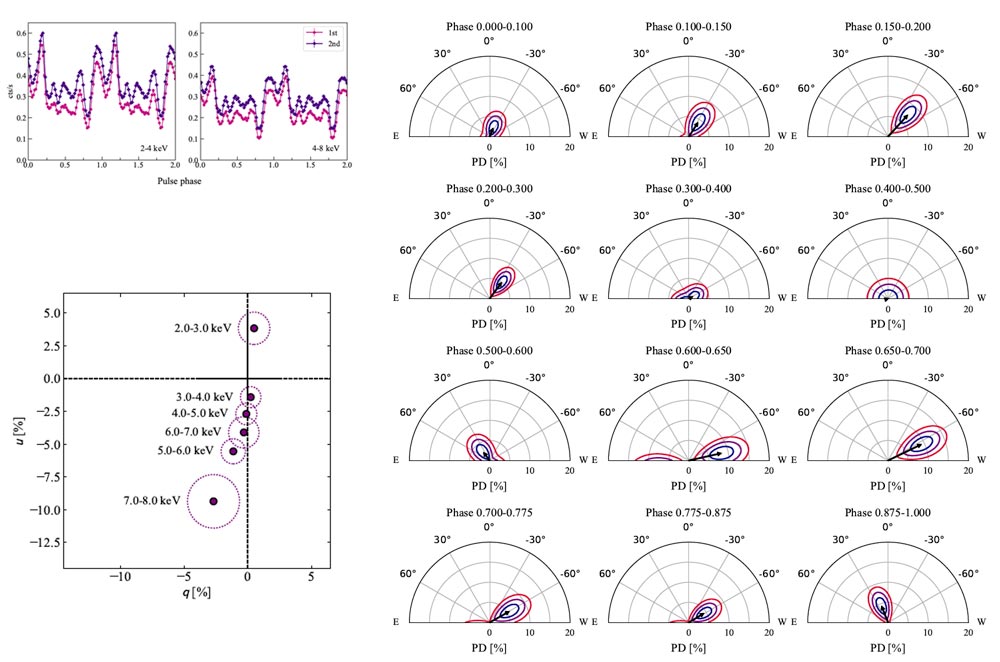
The radiation from accreting X-ray pulsars was expected to be highly polarized, with some estimates for the polarization degree of up to 80%. However, phase-resolved and energy-resolved polarimetry of X-ray pulsars is required in order to test different models and to shed light on the emission processes and the geometry of the emission region. Here we present the first results of the observations of the accreting X-ray pulsar Vela X-1 performed with the Imaging X-ray Polarimetry Explorer (IXPE). Vela X-1 is considered to be the archetypal example of a wind-accreting high-mass X-ray binary system, consisting of a highly magnetized neutron star accreting matter from its supergiant stellar companion. The spectro-polarimetric analysis of the phase-averaged data for Vela X-1 reveals a polarization degree (PD) of 2.3 ± 0.4% at the polarization angle (PA) of -47.3 ± 5.4 deg. A low PD is consistent with the results obtained for other X-ray pulsars and is likely related to the inverse temperature structure of the neutron star atmosphere. The energy-resolved analysis shows the PD above 5 keV reaching 6-10%, and a 90 deg difference in the PA compared to the data in the 2-3 keV range. The phase-resolved spectro-polarimetric analysis finds a PD in the range 0-9% with the PA varying between -80 and 40 deg.
[see the article]
|
|
X-ray pulsar GRO J1008−57 as an orthogonal rotator
Feb 2023
|
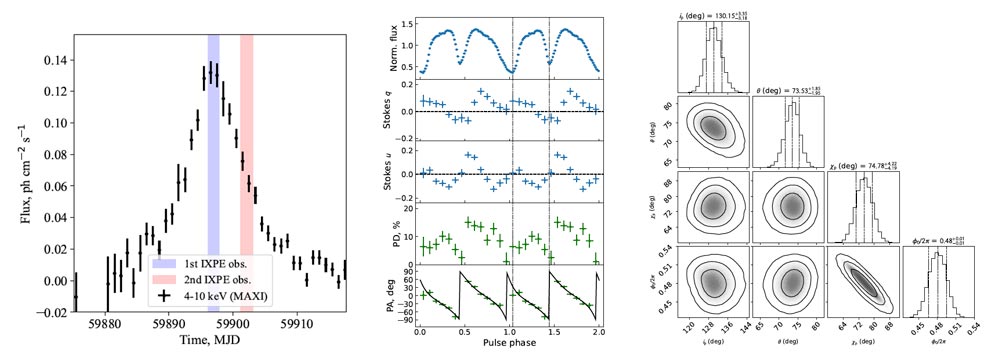
GRO J1008−57 is the first transient X-ray pulsar observed at two different flux levels by the Imaging X-ray Polarimetry Explorer (IXPE) during its outburst in November 2022. The polarization properties were found to be independent of the source luminosity, with the polarization degree varying between non-detection to about 15% over the pulse phase. Fitting the phase-resolved spectro-polarimetric data with the rotating vector model allowed us to estimate the pulsar inclination (130 deg, which is in good agreement with the orbital inclination), the position angle (75 deg) of the pulsar spin axis, and the magnetic obliquity (74 deg). This makes GRO J1008−57 the first confidently identified X-ray pulsar as a nearly orthogonal rotator. The results are discussed in the context of the neutron star atmosphere models and theories of pulsars' axis alignment.
[see the article]
|
|
Outflows influencing beaming, pulsations and pulse phase lags in bright X-ray pulsars
November 2022
|

Extreme accretion in X-ray pulsars (XRPs) results in radiation-driven outflows launched from the inner parts of the accretion disc. The outflows affect the apparent luminosity of the XRPs and their pulsations through the geometrical beaming. We model processes of geometrical beaming and pulse formation and confirm our earlier statement that strong amplification of luminosity due to the collimation of X-ray photons is inconsistent with a large pulsed fraction. Accounting for relativistic aberration due to possibly high outflow velocity (∼0.2c) does not affect this conclusion. We demonstrate that the beaming causes phase lags of pulsations. Within the opening angle of the accretion cavity formed by the outflows, phase lags tend to be sensitive to observers viewing angles. Variations in outflow geometry and corresponding changes of the phase lags might influence the detectability of pulsation in bright X-ray pulsars and ULXs. We speculate that the strong geometrical beaming is associated with large radiation pressure on the walls of accretion cavity due to multiple photons reflections. We expect that the mass loss rate limits geometrical beaming: strong beaming becomes possible only under sufficiently large fractional mass loss rate from the disc.
[see the article]
|
|
Mean opacities of a strongly magnetized high temperature plasma
October 2022
|

Geometry and dynamical structure of emission regions in accreting pulsars are shaped by the interplay between gravity, radiation, and strong magnetic field, which significantly affects the opacities of a plasma and radiative pressure. We present results of computations of the Rosseland and Planck mean opacities of a strongly magnetized plasma with a simple chemical composition: the solar hydrogen/helium mix. We consider all relevant specific opacities of the magnetized plasma including vacuum polarization effect and contribution of electron-positron pairs. We propose a simple approximate expression which has sufficient accuracy for the magnetic Planck opacity description. We provide the Rosseland opacity in a tabular form computed in the temperature range 1 - 300 keV, magnetic field range 3.e10−1.e15 G, and a broad range of plasma densities. We demonstrate that the scattering on the electron-positron pairs increases the Rosseland opacity drastically at temperatures >50 keV in the case of mass densities typical for accretion channel in X-ray pulsars.
[see the article]
|
|
The X-ray polarimetry view of the accreting pulsar Cen X-3
September 2022
|
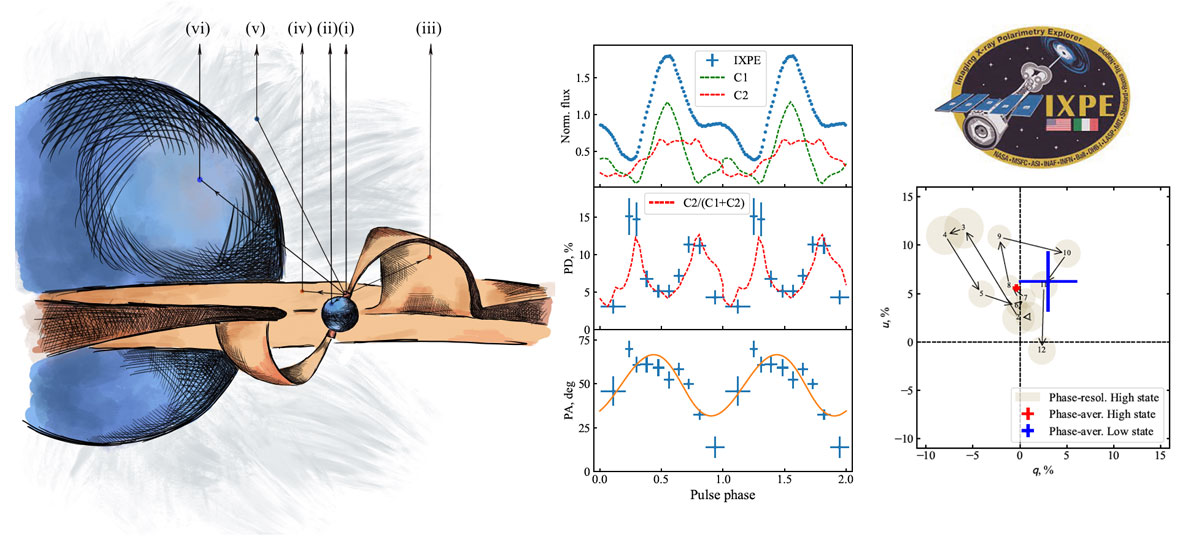
Cen X-3 is the first X-ray pulsar discovered 50 years ago.
We present results of the observations of Cen X-3 performed with the IXPE. The source exhibited significant flux variability and was observed in two states different by a factor of ~20 in flux. In the low-luminosity state no significant polarization was found either in pulse phase-averaged or phase-resolved data.
In the bright state the polarization degree of ~5.8 per cent and polarization angle of ~50 deg was measured from the spectro-polarimetric analysis of the phase-averaged data. The phase-resolved analysis showed a significant anti-correlation between the flux and the polarization degree as well as strong variations of the polarization angle.
The detected relatively low polarization can be explained if the upper layers of the neutron star surface are overheated by the accreted matter and the conversion of the polarization modes occurs within the transition region between the upper hot layer and a cooler underlying atmosphere. A fraction of polarization signal can also be produced by reflection of radiation from the neutron star surface and the accretion curtain.
[see the article]
|
|
Detection of X-ray polarisation in Her X-1 with IXPE!
July, 2022
|
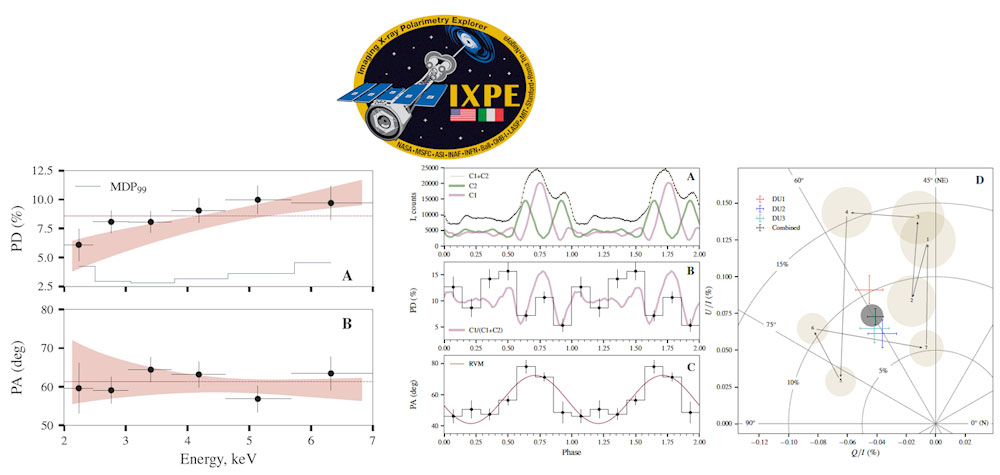
Using observations of X-ray pulsar Her X-1 by the Imaging X-ray Polarimetry Explorer, we report on a highly significant detection of the polarization signal from an accreting neutron star. The observed degree of the linear polarization of ~10 per cents is found to be far below theoretical expectations for this object and stays low throughout the spin cycle of the pulsar. Both the polarization degree and the angle exhibit variability with pulse phase, which allowed us to measure the pulsar spin position angle and magnetic obliquity of the neutron star, which is an essential step towards detailed modeling of the intrinsic emission of X-ray pulsars. Combining our results with the optical polarimetric data, we find that the spin axis of the neutron star and the angular momentum of the binary orbit are misaligned by at least ~ 20 deg, which is a strong argument in support of the models explaining stability of the observed super-orbital variability with the precession of the neutron star.
[see the article]
|
|
Constraints on the magnetic field structure in X-ray pulsars from aperiodic variability
June, 2022
|
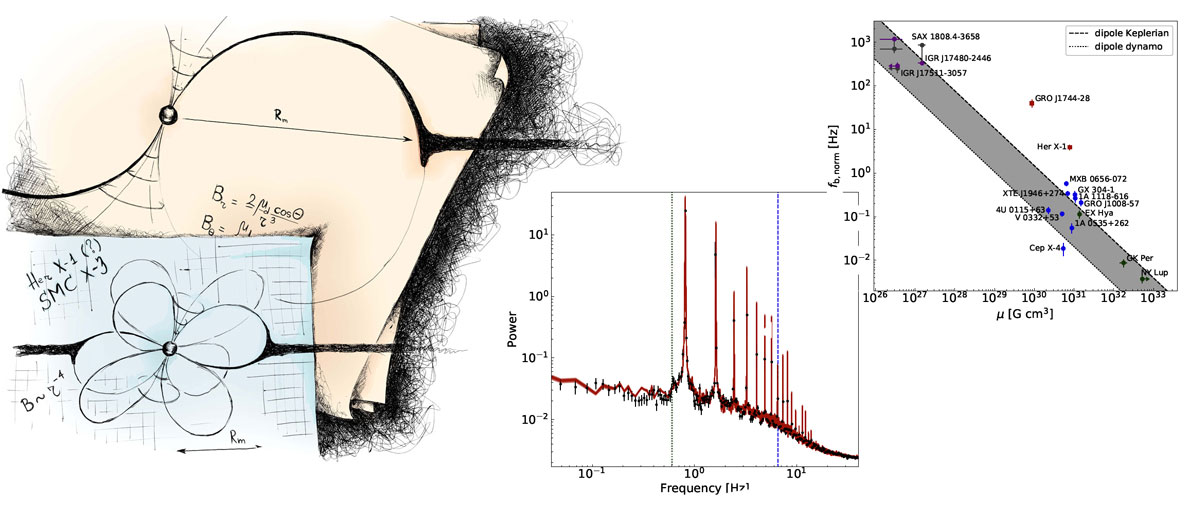
We have investigated the aperiodic variability for a relatively large sample of accreting neutron stars (NSs) and
intermediate polars, focusing on the properties of the characteristic break commonly observed in power spectra of accreting objects. In particular, we investigate the relation of the break frequency and the magnetic field strength, both of which are connected to the size of the magnetosphere. We find that for the majority of objects in our sample the measured break frequency values indeed agree with estimated inner radii of the accretion disc, which allows to use observed break frequencies to independently assess the magnetic field strength and structure in accreting compact objects. As a special case, we focus on Her X-1 which is a persistent, medium-luminosity X-ray pulsar accreting from its low-mass companion.
In the literature, it has been suggested that the complex pulse profiles, the spin-up behaviour and the luminosity-correlation of the cyclotron energy seen in Her X-1 can be explained with a complex magnetic field structure of the NS. Here, we connect the measured break frequency to the magnetospheric radius and show that the magnetic field strength derived assuming a dipole configuration is nearly an order of magnitude smaller than the magnetic field strength corresponding to the cyclotron energy. Accordingly, this discrepancy can be explained with the magnetic field having strong multipole components. The multipolar structure would also increase the accreting area on the NS surface, explaining why the critical luminosity
for accretion column formation is puzzlingly high in this source.
[see the article]
|
|
A new High Mass X-ray Binary in LMC
June, 2022
In a new paper led by Alexander Salganik, we report results of the first detailed spectral and temporal studies of the recently discovered Be/X-ray binary eRASSU J050810.4−660653 in LMC based on the data from the SRG/ART-XC, NuSTAR and Swift/XRT instruments. Pulsations with the period of ~40.6 s were found in the source light curve with the pulsed fraction monotonically increasing with the energy. The orbital period was estimated as ~38 days. The source spectrum can be well approximated with a power-law model modified by an exponential cutoff at high energies. We have not found any features connected with the cyclotron absorption line. However, the neutron star magnetic field was estimated around several 1.e13 G using different indirect methods.
[see the article]
|
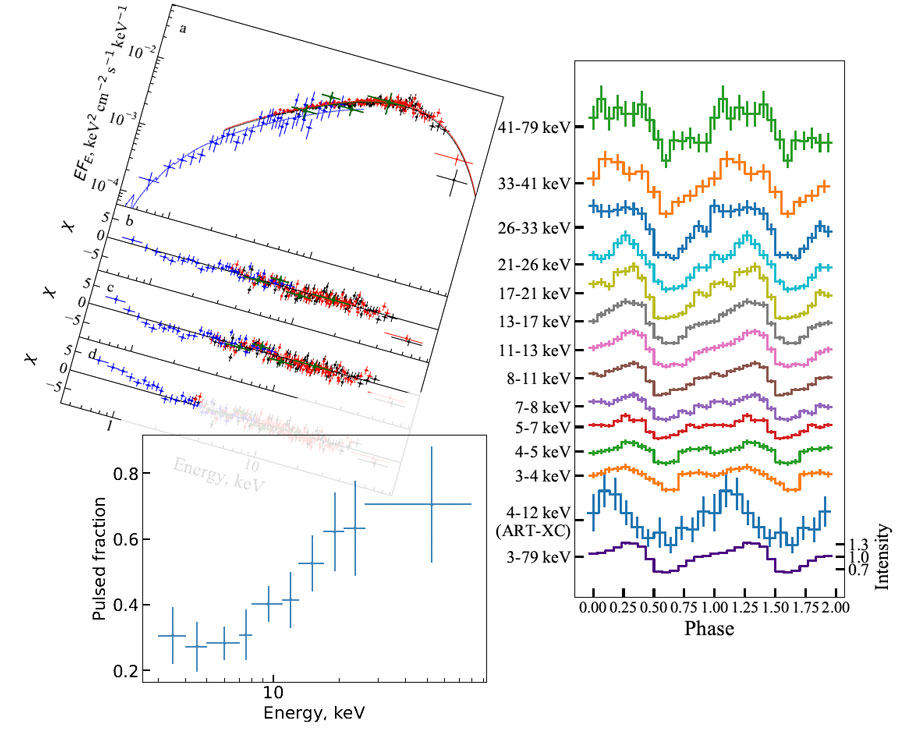
|
Accreting strongly magnetised neutron stars: X-ray Pulsars
May, 2022
|

How does matter fall on neutron stars with a strong magnetic field?
What do we observe, and how do we build theoretical models? X-ray spectra, variability on different timescales, rotation, magnetic field structures, weakest and brightest accreting neutron stars. You will read about this and much more in our review prepared for the "Handbook of X-ray and Gamma-ray Astrophysics".
Enjoy!
[see the article]
|
|
Compton scattering in a strong B-field: statistical features
April, 2022
|
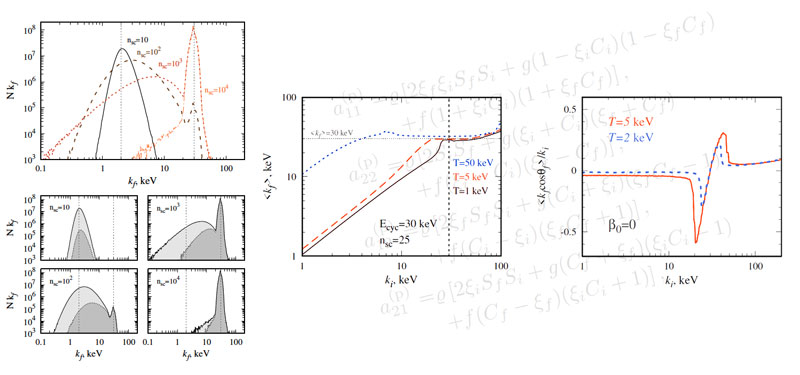
Using Monte Carlo simulations, we investigate statistical features of Compton scattering of polarized X-ray radiation in a strong magnetic field. We take into account the resonant scattering at the fundamental cyclotron frequency, thermal distribution of electrons at the ground Landau level, and bulk velocity of the electron gas. Our analysis shows that (i) the photons scattered around the cyclotron energy by the electron gas at rest tend to acquire the final energy close to the cyclotron one with a very small dispersion measure; (ii) the redistribution of photons within the Doppler core of cyclotron resonance differs significantly from the complete redistribution; (iii) the efficiency of momentum transfer from photons to the electron gas is affected by the temperature of electron gas both for photons at cyclotron energy and below it; (iv) the momentum transfer from photons to the electron gas of non-zero bulk velocity is more efficient in the case of magnetic scattering.
[see the article]
|
|
Spectral transition and stability of cyclotron line in GRO J2058+42
March, 2022
In a new paper led by Alena Gorban, we report on the discovery of spectral transition in X-ray pulsar GRO J2058+42: the typical spectra of accreting strongly magnetised neutron star turns into the two-component spectrum at relatively low mass accretion rates.
This transition is similar to the ones discovered earlier in a few pulsars
(for example, A 0535+262,
GX 304-1),
but the cyclotron line (surprisingly) is detected to be on top of the low-energy component of the spectrum.
We discuss this fact in the framework of existing theoretical models
(see A and
B).
Still, there is something to think about.
In addition, we report the stability of a cyclotron line energy (~10 keV) over the observed luminosity range.
[see the article]
|
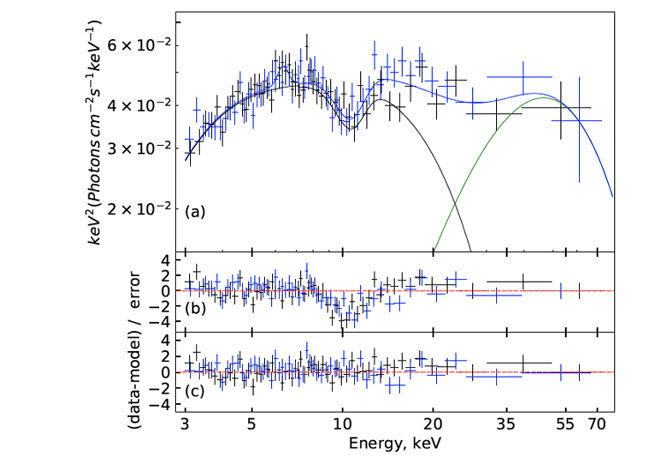
|
SRG/ART-XC, Swift, NICER and NuSTAR study of different states of the transient X-ray pulsar MAXI J0903-531
August, 2021
|

In a new paper we report on the results of the broadband spectral and timing study of the recently discovered transient X-ray pulsar MAXI J0903-531 in a wide range of luminosities differing by a factor of ~30.
It is remarcable that the observed X-ray spectrum in both states can be described as a classical pulsar-like spectrum (the power-law with the high-energy cutoff).
We argue that absence of the spectrum transformation to the two-hump structure expected at low fluxes points to a relatively weak magnetic field of the neutron star below (2-3)×1.e12 G.
This estimate is consistent with other indirect constraints and non-detection of any absorption features which can be interpreted as a cyclotron absorption line.
Timing analysis of the NuSTAR data revealed only slight variations of a single-peaked pulse profile of the source as a function of the energy band and mass accretion rate.
In both intensity states the pulsed fraction increases from 40% to roughly 80% with the energy.
Finally we were also able to obtain the orbital solution for the binary system using data from the Fermi/GBM, NICER and NuSTAR instruments.
[see the article]
|
|
Losing a minute every two years
July, 2021
In our new paper, we investigate peculiar high-mass X-ray binary SXP 1323 located in the Small Magellanic Cloud
The neutron star in this binary is renowned for its rapid spin-up.
Using ART-XC and eRosita, data we produced first broadband 1-20 keV X-ray spectrum and estimated pulsed fraction above 8 keV.
With the addition of archival XMM-Newton observations we traced evolution of the SXP 1323 spin period over the last five years and found that after 2016 the source switched to a linear spin-up with rate of -29.9 seconds per year.
Broadband X-ray spectrum is detected to be typical for accreting X-ray pulsars.
No significant difference between spectra obtained in states with and without pulsations were found.
[see the article]
|
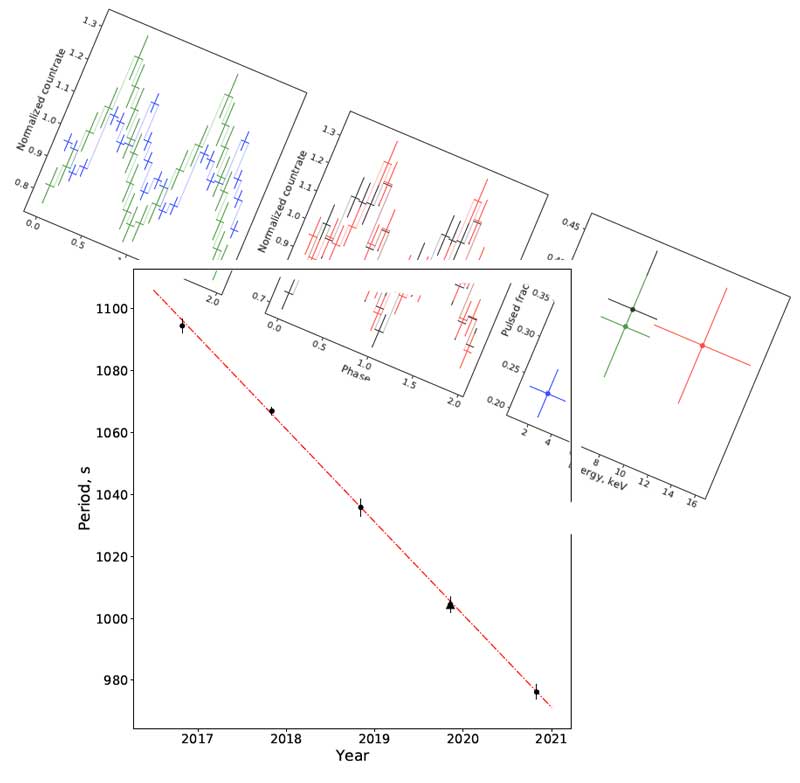
|
Peculiar variations of cyclotron line with luminosity in X-ray pulsar GRO J1008-57
June, 2021
|
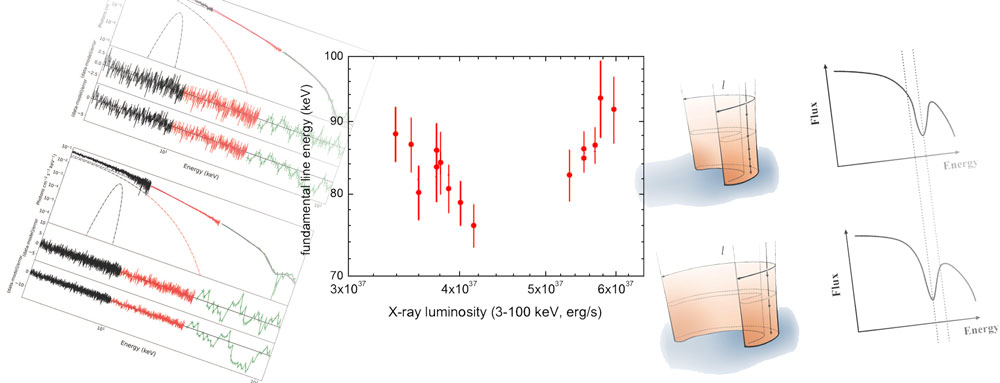
Cyclotron line scattering features are detected in a few tens of X-ray pulsars (XRPs) and used as direct indicators of a strong magnetic field at the surface of accreting neutron stars (NSs).
In a few cases, cyclotron lines are known to be variable with accretion luminosity of XRPs.
It is widely accepted that the observed variations of cyclotron line scattering features are related to variations of geometry and dynamics of accretion flow above the magnetic poles of a NS.
A positive correlation between the line centroid energy and luminosity is typical for sub-critical XRPs, where the accretion results in hot spots at the magnetic poles. The negative correlation was proposed to be a specific feature of bright super-critical XRPs, where radiation pressure supports accretion columns above the stellar surface.
Cyclotron line in spectra of X-ray pulsar GRO J1008-57 is detected at energies from ∼75−90 keV, which is the highest observed cyclotron line energy among XRPs.
In a paper by X.Chen et al. we report the peculiar variations of cyclotron line centroid energies with luminosity in GRO J1008-57.
The cyclotron line energy was detected to be negatively correlated with the NS brightness at L < 4.2e37 erg/s, and positively correlated at L > 5.e37 erg/s.
We speculate that the observed peculiar behavior of a cyclotron line would be due to variations of accretion channel geometry.
[see the article]
|
|
Observations of the X-ray pulsar GRO J1008-57 in the lowest luminosity state
March, 2021
|

We report results of the first broadband observation of the transient X-ray pulsar GRO J1008-57 performed in the quiescent state. Observations were conducted quasi-simultaneously with the Mikhail Pavlinsky ART-XC telescope on board SRG and NuSTAR right before the beginning of a Type I outburst. GRO J1008-57 was detected in the state with the lowest observed luminosity around several ×1.e34 erg/s and consequently accreting from the cold disk. Timing analysis allowed to significantly detect pulsations during this state for the first time. The observed pulsed fraction of about 20% is, however, almost three times lower than in brighter states when the accretion proceeds through the standard disk. We traced the evolution of the broadband spectrum of the source on a scale of three orders of magnitude in luminosity and found that at the lowest luminosities the spectrum transforms into the double-hump structure similarly to other X-ray pulsars accreting at low luminosities (X Persei, GX 304-1, A0535+262) reinforcing conclusion that this spectral shape is typical for these objects.
[see the article]
|
|
X-ray pulsar XTE J1858+034: discovery of the cyclotron line and the revised optical identification
January, 2021
We present results of a detailed investigation of the poorly studied X-ray pulsar XTE J1858+034 based on the data obtained with the NuSTAR observatory during the outburst of the source in 2019. The spectral analysis resulted in the discovery of a cyclotron absorption feature in the source spectrum at ~48 keV both in the pulse phase averaged and resolved spectra. Accurate X-ray localization of the source using the NuSTAR and Chandra observatories allowed us to accurately determine the position of the X-ray source and identify the optical companion of the pulsar. The analysis of the counterpart properties suggested that the system is likely a symbiotic binary hosting an X-ray pulsar and a late type companion star of K-M classes rather than Be X-ray binary as previously suggested.
[see the article]
|
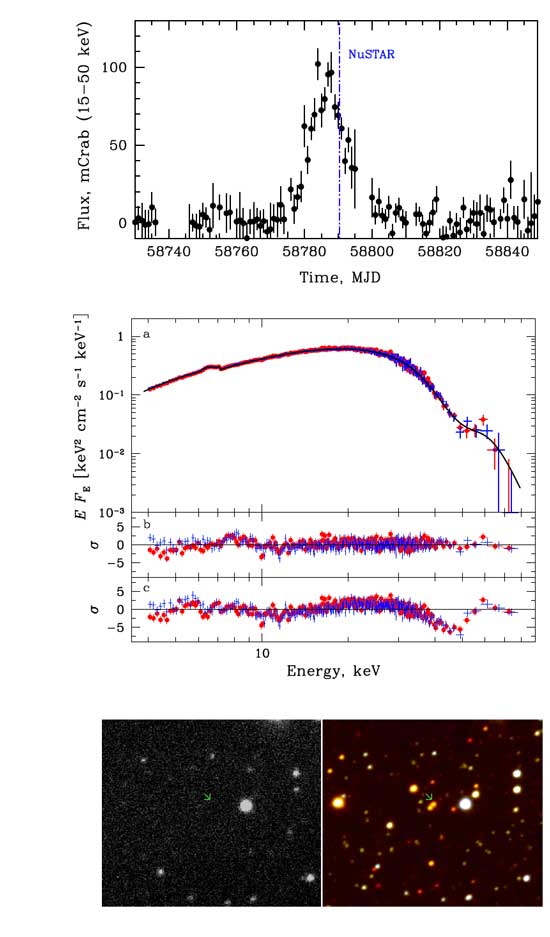
|
News 2017-2020






























